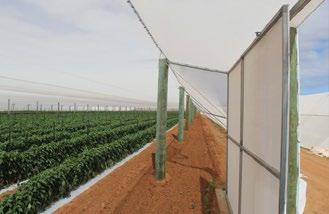
3 minute read
Farm biosecurity practices
Farm biosecurity practices and tomato bacteria disease management
Biosecurity — prevent or minimise the spread of pathogens on the farm.
Advertisement
f THE guttation fluid of infected plant leaf.
BY TRUYEN VO REGIONAL DEVELOPMENT OFFICER, VEGETABLESWA
Farm biosecurity is a set of management practices used to minimise the introduction and prevent the spread of pathogens on the farm. Pathogens are organisms or agents such as but not limit to bacteria and viruses that cause plant disease.
On the other hand, management of tomato bacteria diseases, such as bacterial spot, caused by Xanthomonas campestris; bacterial speck, caused by Pseudomonas syringae; and bacterial canker, caused by Clavibacter michiganensis, also strongly focus on preventing the introduction and spread out of bacteria within and between the growing areas on a farm property. Although these on-farm measures of farm biosecurity practices play a pivotal role in maintaining Australia’s reputation of producing high quality products, farm biosecurity is often perceived as too complex to implement or unnecessary by industry. That may be because the introduction of farm biosecurity systems is often associated with high priority exotic pests, but it’s complimentary actions to reduce risks from both high priority exotic pests and a particular plant pest/disease that immediately concern growers has not been well translated. This article will highlight transmission pathways that are defined for farm biosecurity practices, potential risks for infection and spread out of tomato bacterial diseases and suggested actions to reduce risks.
Complimentary actions to reduce risks
There are six main transmission pathways through which harmful plant pests, diseases, and weeds enter farms. By increasing the awareness of these pathways to industry, growers can then identify the risks that are specific to their growing operations and prioritise actions for reducing the relevant risks. The six main transmission pathways are: 1 Planting materials 2 Waste and weeds 3 Staff and farm visitors 4 Vehicles and equipment 5 Packaging, bins and pallets; and 6 Wind.
In contrast, the four major sources of infection for these bacteria that are defined in literature include: seeds, infected crop debris, volunteer tomato plants, and on contaminated surfaces of equipment (farm machinery, sticks and tools). Other important factors spreading the bacteria are splashing water and wind-driven rain or mists produced during storms, and workers that spread the guttation fluid of infected plants1 whilst doing clipping, pruning or picking when the plant canopy is wet2 . Thus, the common risks identified in both strategies are perfectly matched: (i) Seeds/planting material; (ii) Waste/ infected crop debris; (iii) Weeds/ volunteer tomato plants; and (iv) Vehicle and equipment/farm machinery and equipment; (v) Staff and farm visitors/ workers; and (vi) Wind/ splashing water and wind-driven rain or mists produced during storms. Therefore, planning and implementing farm biosecurity properly is absolutely consistent with efforts to manage tomato bacteria diseases indeed.
Resources
A great source of information to help growers plan and implement efficient farm biosecurity is available at www.farmbiosecurity.com.au/industry/ vegetables. The available resource manuals for the vegetable industry and other documents such as the farm biosecurity planner and checklist outline the recommendations on farm biosecurity practices that aim to reduce the risk of pests and diseases.
Information specific to the management of tomato bacterial diseases is provided in the previous article starting on page 18. The article will help growers to build understanding of this problem, the key characteristics of the pathogens’ biology; inoculation and spread; and recommendations on chemicals spray. Identify the risks specific to your growing operations. VegNET RDO at vegetablesWA, Truyen Vo, is happy to visit growers’ farms to implement farm biosecurity. Truyen has 75 high-quality farm biosecurity signs to giveaway to growers who arrange for him to visit on a ‘first come — first served’ basis.
1 https://bsppjournals.onlinelibrary.wiley.com/doi/pdf/10.1111/j.1365-3059.2012.02673.x 2 Please see the article “Tomato Bacterial diseases control need more than just chemicals spray” on page 18
MORE INFORMATION
Truyen Vo, Regional Development Officer, phone (08) 9486 7515, 0457 457 559 or email truyen.vo@vegetableswa.com.au
0437 203 024 cropnets@bigpond.com














